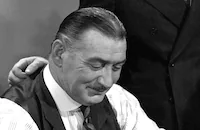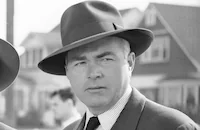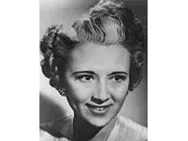I Am the Law
Brief Synopsis
Cast & Crew
Alexander Hall
Edward G. Robinson
Barbara O'neil
John Beal
Wendy Barrie
Otto Kruger
Film Details
Technical Specs

Synopsis
Law professor John Lindsay leaves college to begin a sabbatical he dreads. His wife Jerry, however, looks forward to finally having a vacation, and sends John to a movie while she packs. John finds the theater has been hit by a stench bomb, but the manager is afraid to report the crime because it is the result of rival extortion rackets. Eugene Ferguson, a member of the Governor's Civic Committee, suggests John be appointed as special prosecutor to clear the city of racketeers. Ferguson is in cahoots with the racketeers and quickly informs mob heavy, Moss Kitchell, that John can be handled and will keep the G-men at bay. When John learns that all witnesses have been intimidated and refuse to testify, he seeks the books of their companies. Ferguson tells his mistress, Francis "Frankie" Ballou, a newspaper columnist, that the racket will soon be an accepted part of business overhead. Later, Frankie takes John to the Cafe Martin, and as she dances with Kom Cronin, Ferguson's rival, who was to meet John and provide information for the case, Cronin is shot by Eddie Girard, Ferguson's gunman. John loses his appropriation, but now he knows Frankie and Ferguson are guilty. Meanwhile, Jerry persuades extortion victim J. W. Butler to testify, but Eddie kills him first. John suspects that someone on his staff is leaking information, and he fires everyone and hires an entire new staff. After John is asked to resign, he sets up his own investigation. After several criminals are apprehended for following Mrs. Butler, John invites newspaper photographers to watch him beat up the men to prove they are not so tough. Ferguson sends Eddie to shoot John, but he is captured. With citizens protesting the racketeer's continued dominance, the governor forces John to clean up the case in twenty-four hours. All the known crooks are arrested, regardless of the evidence against them, prompting Moss Kitchell to offer to help John. Before Kitchell can inform on the racket, he is found dead, and John's assistant, Paul Ferguson, who is Ferguson's son, is shocked to pick up the telephone next to the body and hear his father's voice. Witnesses finally agree to testify, and John shows Frankie and Ferguson film of Frankie killing Kitchell. John agrees to save Frankie from the chair if she writes her story, but Ferguson is forced to sign a will which leaves his fortune to the Butlers and the investigation. Then, knowing John's car has been sabotaged, Ferguson asks to borrow the keys, and is blown up. With the town cleaned up, and his sabbatical over, John goes back to teaching, leaving Paul to carry on in his place.

Director

Alexander Hall
Cast

Edward G. Robinson

Barbara O'neil

John Beal

Wendy Barrie

Otto Kruger
Arthur Loft
Marc Lawrence
Douglas Wood
Robert Middlemass
Ivan Miller

Charles Halton

Louis Jean Heydt

Fay Helm
Asta
Joe Downing
Emory Parnell
Theodore Von Eltz
Horace Macmahon
Sammy Finn
Frederick Burton

Lucien Littlefield

Ed Keane

Robert Cummings
Harvey Clark

James Flavin
Harry Bradley
Edward J. Lesaint
Billy Arnold
Frank Mayo
Oliver Eckhardt
Kane Richmond
James Bush
Anthony Nace
Robert Mcwade Jr.
Will Morgan
Walter Soderling
Scott Colton
Marshall Ruth
Nick Lukats
Alan Bruce
Philip Grant
Gaylord Pendleton
Ed Fetherston
Bud Jamison

Iris Meredith
Mary Brodel
Frank Bruno
Jack Woody
Chick Collins
Joseph De Stefani
George Pearce
George Turner
Charles Hamilton
Bud Wiser
Lane Chandler
Eddie Foster
Jeffrey Sayre

Phil Smalley
William Worthington
Lee Shumway
Ed Thomas
Walter Anthony Merrill
Lester Dorr
Reginald Simpson
Cyril Ring
Allen Fox
Charles Sherlock
Ernie Alexander

Bess Flowers
Lloyd Whitlock
J. G. Macmahon
Eugene Anderson Jr.
Russell Houstis
Crew
Lionel Banks
Harry Cohn
Lodge Cunningham
Henry Freulich
Stephen Goosson
Paul Jarrico
Babs Johnstone
Kalloch
Viola Lawrence
William Mull
Everett Riskin
Morris Stoloff
Jo Swerling

Videos
Movie Clip


Trailer
Film Details
Technical Specs

Articles
I Am the Law on DVD
Robinson plays a New York law professor named John Lindsay -- no relation to the later real-life mayor of NYC, but actually based on New York's then-D.A. Thomas Dewey, who crusaded against the rackets. In the film, Lindsay is about to leave town on a sabbatical when he is asked to take on the job of cleaning up the city's rampant corruption, as organized crime has achieved a stranglehold. Robinson takes the job thinking he can rectify things quickly, only to discover that the corruption has infected even his own staff. Someone is leaking his plans to the rackets, frustrating his every step. When his lack of progress gets him fired from his post, he carries on as a private citizen, working out of his home with an army of trusty, former law students, and it is here that the film really picks up speed and entertainment value.
More to the point, the story finally allows for Robinson to start blazing on all cylinders, at least verbally, as in the scene where he fires his corrupt staff in an impassioned speech, or in the one where he implores his former students to work with him. I Am the Law is a solid little picture, but it's really Edward G. Robinson's show.
He does get a little physical action in, during a very funny sequence in which he lectures two thugs on hoodlum psychology. In front of a roomful of people, he declares how cowardly they are when they're unarmed and alone, and then proceeds to beat them up, all while a newspaper editor is there dictating the story over the phone, as if calling a boxing match!
The supporting cast of this Columbia picture is solid as a rock, with Otto Kruger and his typical smiling, evil visage; Wendy Barrie enticing Robinson to dance the Big Apple on a nightclub dancefloor just as Robinson's wife enters the room; and Marc Lawrence, the eternally pockmarked, scowling henchman, demonstrating good comic timing in a scene in which he breaks into a house only to be flummoxed by a cute little terrier -- and then by Robinson accidentally shooting the gun right out of Lawrence's hand. The scene's satisfying blend of action and comedy epitomizes the film.
Director Alexander Hall paces these scenes very well and is to be commended for drawing out the Big Apple dance sequence, for the sight of Robinson clearly having a ball while he dances (purposefully) badly is one for the books.
The main weakness of the movie is too much talkiness as well as a lack of true emotional interest in the characters -- not enough to make us care much about the subplot of Kruger's law-student son (John Beal) building a truer father-son relationship with Robinson than with his evil dad. Possibly this is the result of the shifting tone of the piece keeping us at a distance. Still, Robinson delivers and I Am the Law will satisfy his fans. It's a better film than its "standard programmer" reputation suggests.
Sony Choice Collection's made-on-demand DVD-R of I Am the Law looks and sounds acceptable enough. There are no extras.
By Jeremy Arnold

I Am the Law on DVD
I Am the Law
Very loosely based on the career of New York Prosecutor Thomas E. Dewey, I Am the Law isn't particularly believable but Robinson pulls it off. He plays a special prosecutor named John Lindsay who's recruited to rid the local government of shady characters with mob connections. A former professor, Lindsay quickly gathers a group of loyal law students who help him find any mob-connected types at City Hall. You've obviously never watched one of these potboilers if you think they fail in their quest.
Robinson wrote in his autobiography, All My Yesterdays, that he was trying to convince Warner Bros. he should be allowed to star in Confessions of a Nazi Spy (1939) when I Am the Law was put on his plate. Unfortunately, the studio wasn't interested in the Nazi picture at that point, even though it owned the script and had partially prepared it to be filmed. Robinson accepted I Am the Law simply because he was contractually obligated to do so. (Robinson would get his wish and go on to star in Confessions of a Nazi Spy a year or so later. Reflecting his openly Leftist leanings, it would be the first anti-Nazi picture released by Hollywood.)
Robinson, a politically-aware actor if ever there was one, also noted in his book that his character in I Am the Law was named John Lindsay, and had become a prosecutor in the hopes of eventually being elected mayor of New York. In real life, John V. Lindsay was elected mayor of the Big Apple in 1966, a coincidence that obviously delighted Robinson. It seems unlikely that I Am the Law had anything to do with it!
Director: Alexander Hall
Producer: Everett Riskin
Screenplay: Joe Swerling (based on a story by Fred Allhoff)
Photography: Henry Freulich
Editing: Viola Lawrence
Music: Morris Stoloff
Art Director: Stephen Goosson, Lionel Banks
Costumes: Kalloch
Art Direction: Babs Johnstone
Sound: Lodge Cunningham
Principal Cast: Edward G. Robinson (John Lindsay), Barbara O'Neil (Jerry Lindsay), John Beal (Paul Ferguson), Wendy Barrie (Frankie Ballou), Otto Kruger (Eugene Ferguson), Arthur Loft (Tom Ross), Marc Lawrence (Eddie Girard), Douglas Wood (District Attorney Beery), Robert Middlemass (Moss Kitchell).
B&W-83m.
by Paul Tatara
I Am the Law
Quotes
Trivia
Notes
The working title of this film was Outside the Law. Asta, the terrier, also appeared in the "Thin Man" series. According to Edward G. Robinson's autobiography, he made the picture while under contract to Warner Bros. by exercising a special option to make films outside the studio. Like the Variety review, Hollywood Reporter calls I Am the Law "another of the Dewey cycle of pictures," referring to New York City district attorney Thomas E. Dewey.















